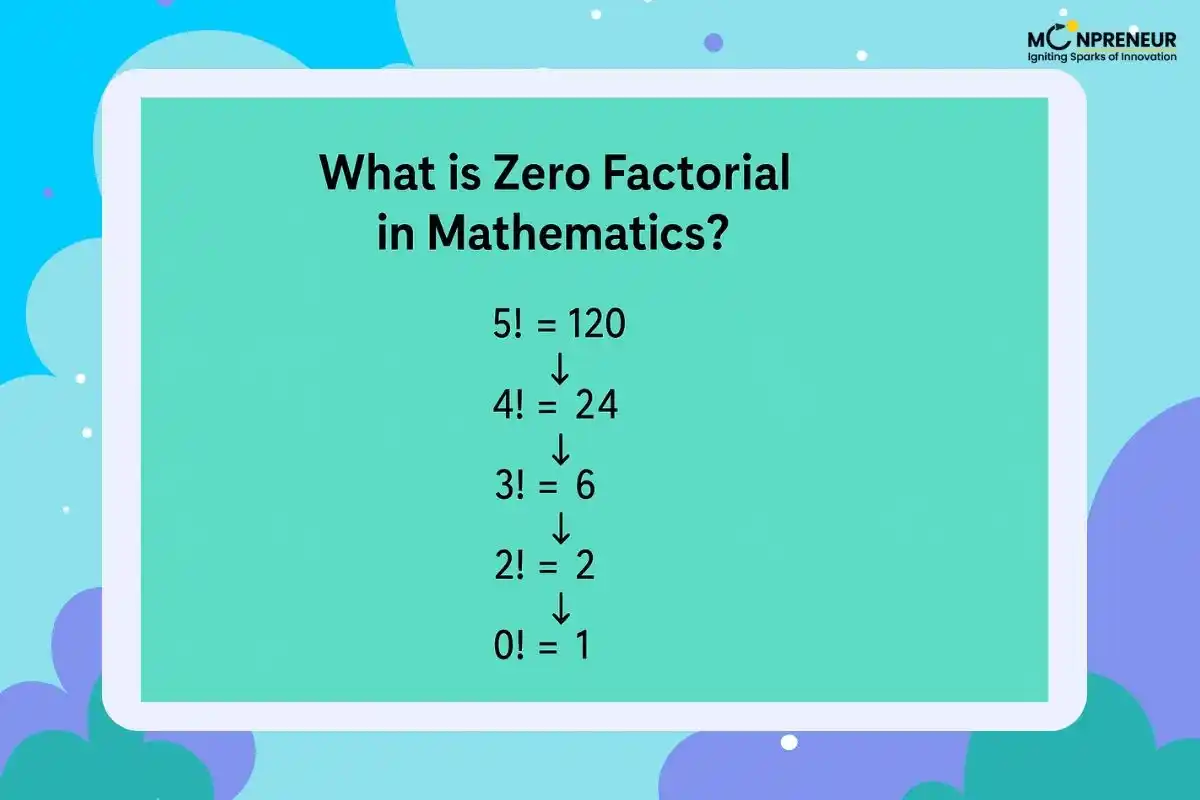
Factorials are everywhere in mathematics—from simple counting problems to advanced probability theories. While most students understand factorials for numbers like 3! or 5!, they often get confused when they encounter 0! (zero factorial). Why does mathematics say that 0! = 1? Let’s break it down step by step.
Recap: Factorials in Mathematics
A factorial (n!) is the product of all positive integers from 1 up to n.
Formula:
\(\displaystyle n! = n \times (n – 1) \times (n – 2) \times \dots \times 3 \times 2 \times 1\)
👉 Example:
- \(\displaystyle 4! = 4 \times 3 \times 2 \times 1 = 24\)
- \(\displaystyle 5! = 5 \times 4 \times 3 \times 2 \times 1 = 120\)
Factorials are useful in arrangements (permutations), selections (combinations), algebra, probability, and calculus.
So, what is Zero Factorial (0!)?
By definition, 0! = 1.
At first, this feels strange. How can "the product of nothing" equal one? The answer lies in logic, consistency, and mathematical convention.
Why is 0! = 1?
1. Combinatorial Reason (Arrangements)
Factorials count the number of ways to arrange objects.
\(\displaystyle 3! = \text{number of ways to arrange 3 objects} = 6\)
\(\displaystyle 2! = \text{number of ways to arrange 2 objects} = 2\)
Now, what if we have zero objects?
There’s exactly one way — do nothing.
\(\displaystyle 0! = 1\)
2. Recursive Formula Reason
Factorials follow the formula:
\(\displaystyle n! = n \times (n - 1)!\)
For n = 1:
\(\displaystyle 1! = 1 \times 0!\)
But we know \(\displaystyle 1! = 1\).
So, \(\displaystyle 1 = 1 \times 0! \Rightarrow 0! = 1\)
3. Gamma Function Proof
The gamma function (\(\displaystyle \Gamma\)) generalizes factorials to real numbers:
\(\displaystyle n! = \Gamma(n + 1)\)
If we plug in 0!:
\(\displaystyle 0! = \Gamma(1) = 1\)
This proves mathematically that \(\displaystyle 0! = 1\).
Applications of Zero Factorial (0!)
Zero factorial is not just a curiosity — it plays a big role in real mathematics.
1. Combinations Formula
The formula for combinations is:
\(\displaystyle C(n, r) = \frac{n!}{r!(n - r)!}\)
Example:
\(\displaystyle C(5, 0) = \frac{5!}{0! \times 5!} = 1\)
This means there is only one way to choose nothing from 5 objects.
2. Permutations Formula
Permutations formula uses factorials:
\(\displaystyle P(n, r) = \frac{n!}{(n - r)!}\)
When \(\displaystyle r = 0\):
\(\displaystyle P(n, 0) = \frac{n!}{n!} = 1\)
Again, \(\displaystyle 0! = 1\) is consistent.
3. Binomial Theorem
The binomial expansion formula:
\(\displaystyle (x + y)^n = \sum_{r=0}^{n} \frac{n!}{r!(n - r)!} x^{n - r} y^r\)
Without defining \(\displaystyle 0! = 1\), this formula would break when \(\displaystyle r = 0\) or \(\displaystyle r = n\).
Historical Background
The use of factorials dates back to the 18th century.
- The notation n! was introduced by Christian Kramp in 1808.
- Mathematicians later agreed that defining 0! = 1 makes equations simpler and consistent.
Factorial Sequence Example
| n | n! Value |
|---|---|
| 5 | 120 |
| 4 | 24 |
| 3 | 6 |
| 2 | 2 |
| 1 | 1 |
| 0 | 1 |
Notice how the pattern smoothly continues when 0! = 1 is used.
Fun Facts About 0!
- In probability, 0! is used when calculating the number of ways to choose nothing.
- Without 0! = 1, many formulas like Pascal’s triangle and binomial coefficients would fail.
- The idea of “one way to do nothing” is used in computer science as well, when counting empty sets or base cases in recursion.
Conclusion
Zero factorial (0!) may look confusing, but in reality, it is one of the most important definitions in mathematics. Defining 0! = 1 ensures that formulas in probability, algebra, permutations, and combinations work smoothly.
👉 Always remember: Factorials count arrangements, and there’s exactly one way to arrange nothing—so 0! = 1.
Want to spark your child’s interest in math and boost their skills? Moonpreneur’s online math curriculum stands out because it engages kids with hands-on lessons, helps them apply math in real-life situations, and makes learning math exciting!
You can opt for our Advanced Math or Vedic Math+Mental Math courses. Our Math Quiz for grades 3rd, 4th, 5th, and 6th helps in further exciting and engaging in mathematics with hands-on lessons.
Frequently Asked Questions (FAQ)
Ans: Because there is one way to arrange zero objects—doing nothing.
Ans: Both—it is a convention, but it is also mathematically consistent using formulas and the gamma function.
Ans: In probability, statistics, permutations, combinations, and algebraic expansions.
Ans: Yes, it is a universal rule in mathematics.
















